Sampo in the Finnish national epos Kalevala has a long time ago been identified as the world pillar, axis mundi. The world pillar is a common feature in Arctic and Siberian mythology. The name Sampo most probably comes from the Sanskrit word shambha, pillar. This pillar connects the earth to the sky. It is fixed to the sky with a golden nail, the polar star. The sky turns around the pillar. The poem “Theft of Sampo” in Kalevala seems to be directly connected to a change of the polar star, probably around 1000 AD when Polaris was slowly adapted as the polar star instead of deriving the place of the celestial North Pole from Kocbah.
The celestial North Pole moves in a circle around the center point, which is situated in the Draco constellation. One round takes 25,770 years and the mechanism causing this movement is precession, the slow movement of the axis of rotation in a gyroscope. In the case of the Earth this movement is for unknown reasons called precession of equinoxes. Equinox is a time: a day when the day and night are of equal length. Equinox changes because of precession, but the movement would be more logically called precession of the Earth axis.
Already 1983 Ugo de Santillana and Ertha Von Dechend argued in [1] that all ancient cultures knew the precession of equinoxes. Giulio Magli in [2] is more cautious. He presents evidence that while astrologists of many ancient cultures may not have understood the precession, they were aware of the slow movement of fixed stars, including that the polar star changes in a long time. Magli gives many examples, one being the sanctuary of Son Mas in Majorca. It was constructed to be oriented towards the star Cruz-Centarios. The star constellation moved below the horizon as seen from Malta around 1700 BC and according to archeologists the sanctuary was abandoned at just around that time. These kind of examples make a good case that latest around 1700 BC European astrologers knew that fixed stars moved to new positions in some hundred or thousands of years.
The concept of world times is closely related: ancient people thought that the time is divided into ages. Each age ends to a catastrophe. One of the catastrophes is the moving of the world pillar. As a polar star is a nail, which fixes the pillar, it is of outmost importance if there is a polar star or not. But this is only a theory and a later development. This theory must have been created to explain why in certain times in the past happened catastrophes. I suggest that certain major catastrophes indeed happened because the polar star changed, so there was a connection which later was elaborated into a theory. This proposed connection between a catastrophe and a polar star is nothing mystical. I do not suggest that radiation from stars influenced life on the Earth. The catastrophe was caused by a new people arriving to the area and destroying the old culture. It has happened several times in Europe, most notably in the Bronze age when the Indo-Europeans arrived, but also in more recent times. There is nothing mystical in proposing that the arrival of a new people is connected with a polar star. A polar star probably made orientation much easier in prehistoric times when there were no compasses or calculation methods, thus at times when there was no polar star we would expect that people were migrating less, while when a polar star appeared in the sky some belligerent people might have started looking for a new land to conquer. As a consequence, existing cultures were replaced by new ones and we can investigate if this proposal makes sense by looking if there is any connection between the change of polar stars and the change of cultures.
Naturally, a polar star is not the only or the main reason fro migrations. There are many reasons, such as a new technology (like agriculture, horses, metal weapons), overpopulation (like Europeans moving to other continents) of pressure from other peoples (like the Goths were pressed by Huns). In prehistoric Europe a major reason for migrations were climatic changes, which force animals and humans to move. There was the Ice age and consequent melting of ice. There is no real connection between climatic changes and the change of the polar star, but an apparent connection between the two was created in the theories of world ages by synchronizing these unrelated mechanisms. Climatic changes have certain quasi-periodicity: after the last Ice age there has been a roughly 2000 year period of global warming and inside it a weaker 1000 year period, maybe oscillations in the climate after the ice melted. The polar star changes are strictly periodic and 2000 years is a relevant time: one polar star is close to the celestial North Pole for about 2000 years. It is only needed to synchronize these two, which was done in the zodiac theory of ages.
The zodiac was created in Babylonia around 500 BC from earlier star maps used from 1600-1000 BC to track the movement of planets. The Babylonians divided the zodiac into 12 zodiac signs. Instead of tracking the polar star, they focused on astrological ages. An astrological age is the time when the sun raises in one zodiac sign in the spring equinox. With exactly 12 zodiac signs the average length of an astrological age is 2148 years, 12th the Platonic year, i.e., precession cycle of 25,770 years. The astrological age is synchronized with the global warming cycle: the last warmer time was around 0 AD (so, there is one now in 2000 AD) and the astrological age changed to the age of Pisces also around 0 AD. It is probably not a coincidence but a result of purposeful design of the astrological age theory, and it means that the zodiac based astrological age had replaced the polar star based world age around 1000-500 BC.
We can find the correlation between the polar star and migrations after this time frame only from cultures, which were too far from the cultural centers which created the new zodiac based astrology, such as Finns, Saami and Siberian Arctic people. Some of these northern cultures still expected the end of the age and destruction of the world by fire if the world pillar moved. The belief of destruction with fire seems to have very old roots. Shambha is not only a pillar in Indian Veda tradition: it is also closely connected with a friction drill for making fire.
Let us now look for the suggested correlation between the polar stars and cultures from prehistoric Europe. According to a recent DNA study [3] Europe was populated in several migrations. The first migration brought the Aurignacian culture 45,000 BC. Aurignacian people came from the Middle East. Their Y-DNA haplogroups were C1, F and pre-I and mtDNA included N (notably U) and M lineages. Around 31,000 BC came from East Europe genetically different people, the Gravettian, who occupied most of Europe until 20,000 BC or even up to 15,000 BC. Their Y-DNA haplogroups were C1 and pre-I and mtDNA haplogroups belonged to U. The Aurignacian culture did not disappear: they reoccupied Europe starting around 17,000 BC as the Magdalenian culture. Their Y-DNA haplogroups were I and I2 and mtDNA haplogroups were subgroups of U, notably U5. Around 12,000 BC appeared genetically different people, probably from the Middle East. One site from 12,000 BC, Villabruna, had an individual with the Y-DNA haplogroup R1b1a, also E1b1b is from this time. The early Neolithic farmers moved to Europe around 6,000 BC from Anatolia. Their Y-DNA haplogroups were mostly G2a. The common mtDNA haplogroup H and several other present mtDNA haplogroups probably came to Europe with these farmers. New people from the Pontic-Caspian Steppe carrying Y-DNA haplogroup R1b replaced most of the paternal lineages in Western Europe around 3000 BC. While there was some R1b in Europe already 12,000 BC, these new lineages are from different subhaplogroups. It seems that these R1b people did not replace mtDNA, so they were mostly male groups, maybe war bands. A bit later, around 2,600 BC a new wave of Indo-Europeans came bringing the R1a Y-DNA haplogroup. As science is what it is, these results may change when new studies are made, but the big picture is probably already fairly correct.
Those were the cultures, more or less, what about the polar stars?
Nine stars, which are visible to a naked eye, move to a position, which is sufficiently close to the North Pole for them to be used as polar stars, but some of them are quite dim. These stars are not placed evenly in the sky and there are long intervals when there is no polar star in the sky. During the time modern humans have inhabited Europe I expect that humans would have noticed the following polar stars: from 45,000 BC to 17,000 BC they could notice Deneb, Vega, Hercules constellation, Draco constellation and Polaris, and from 17,000 BC to the present time they could also notice some dimmer stars, so the list is Deneb, Vega, Tau Herculis, Thuban, Kochab and Polaris, our present polar star, which has been used from about 1,100 AD.
Polar stars are easily noticeable celestial objects only in sufficiently Northern latitudes (covering all of Europe and Mediterranean). In higher latitudes the whole night sky is seen turning around the celestial North Pole. In the tropics raising the celestial North Pole is very low in the horizon and people used different markers, such as observing which starts were raising in selected directions. Since the night sky turns around the celestial Northern Pole, that place governs the sky and it is where the gods were thought to live. Consequently circumpolar stars, those around the Pole and which stay up in the sky whole night, were identified with gods. There are indications that Europeans were observing polar stars already in the Paleolithic Stone age.
The oldest known description of a polar star, and maybe even of the shift of the polar star, is the Bird man fresco in the Lascaux cave. Michael Rappenglueck proposed in 1998 that the eyes of the bird man, the bird on a pole and the bison are the three bright stars Deneb, Vega and Altai, the Summer Triangle (eyes in yellow). The fresco is dated 15,300 BC. Deneb was closest star to the North Pole around 15,770 BC and Vega around 12,000 BC. Deneb is the brightest star in Cygna (Swan) and Altair is the brightest star in Aguila (Eagle). The shaman has a birds head and hands out stretched, resembling Cygna. Vega should be the eye of a bison. It requires conceptualizing Lyra, Hercules and some other stars as a bison. The fresco is probably just a star map, but it could be understood as a prediction that Vega overcomes Deneb as the polar star, which happened 4000 years after the fresco was painted.
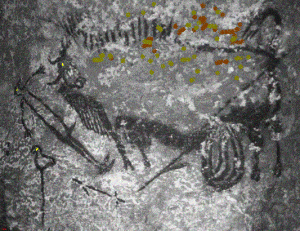
If we accept this interpretation, which seems very natural, and agree that in Lascaux, a descendant of the Aurignacian culture, there is imaginary of a polar star, then polar stars may have been important also to the earlier Aurignacian culture. The Aurignacian culture appeared abound 43,000 BC and was replaced by the Gravettian culture around 31,000 BC. Deneb was the closest star to the celestial Northern Pole in 41,500 BC, but it was sufficiently close already in 43,000 BC: it never gets very close, but it is a very bright star, so it does not matter if it is exactly in the closest place. Vega was closest to the Pole in 37,800 BC, but as it also is very bright and never very close to the Pole, it could be used as a polar star probably until 35,000 BC. After this time the Aurignacian culture disappeared, but DNA studies show that some people survived in Spain. They expanded again around 15,000 BC as the Magdalenian cultures. This is the time when Deneb was again the polar star. Between the Gravettian and Magdalenian cultures there was the Solutrean culture in Spain and France. It probably was a continuation of the Aurignacian culture. It started around 19,000 BC, some 3000 years before Deneb was the closest star to the celestial North Pole, but as already mentioned, Deneb is bright and never very close to the Pole and the time of Deneb as the marker of the Pole can be started 2000-3000 years earlier.
After Deneb and Vega the next polar star is Tau Herculis around 34,000 BC, then Thuban of Draco, which was very close to the celestial North Pole around 28,600 BC. Both Tau Herculis and Thuban are dim starts, but the constellations Hercules and Draco are easy to spot. Paleolithic people could have noticed the constellations, but probably not the polar stars. The next bright star is Polaris, which was closest to the Pole 23,700 BC. The Gravettian culture is usually dated between 31,000 BC and 15,000 BC, but these times vary depending on the source. Some sources set the start of Gravettian to 32,000 BC. Most sources give the ending time of Gravettian as 20,000 BC. It is some 2000 years after Polaris could not any more show the Pole. These times do not match very well to the polar stars. Gravettian does not seem to have neither started nor ended as a response to a new polar star. Gravettian people replaced the declining Aurignacian culture and were pushed away by the emerging Magdalenian culture, which both correlate with new polar stars. It may be that the Aurignacian people were more focused on following polar stars.
We can still look as celestial symbols from Gravettian. The most characteristic art objects of Gravettian are the Venus figurines. They have very explicit female sexual identifiers and it is natural to interpret them as fertility symbols. They may represent a fertility goddess. Gods often have a celestial image. The star constellation Hercules, which is seen up side down, can be conceptualized as a female goddess, not up side down, especially this relief:
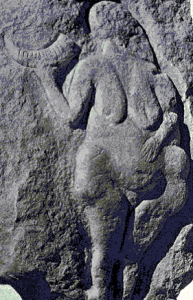
Comparing it to the Hercules constellation shows certain similarity, as an easy application of the common observation that in the stars you can see what you want to see. The arrows point out something that is not obvious. The right tight in the relief is bulged, which can be explained by the stars of Hercules, and the drinking horn is there, though in another position.
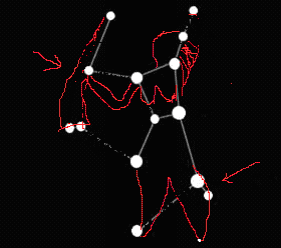
Hercules was the constellation closest to the celestial North Pole until the polar star moved to Draco, so we should find two constellations, Hercules and Draco. A Gravettian statue known as Balzi Rossi Beuty and the Beast shows a woman and a snake. The figures are connected from the head and legs. Draco is close to Tau Herculis, which is a star in the woman’s head. Draco does not connect to the woman’s feet, but there is another snake shaped constellation close to the feet, Serpent’s Caput. While it may not be so obvious from the drawing, there is no mistake in identifying one figure as the woman by the breasts, navel and buttocks and the snake by the snake head and scales in the body.
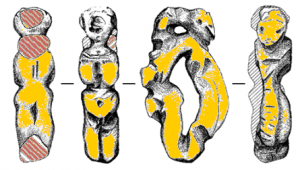
Early Gravettian art also includes many bird figurines. They are typically interpreted as male sexual symbols, which can very well be true. Still a bird figure has a celestial image in Cygna, the Swan. If it is true that Gravettian was a matriarchic society, it may be because the patriarchic time of Deneb had passed. The figure shows a stylized bird from the early Gravettian Mal’ta culture.
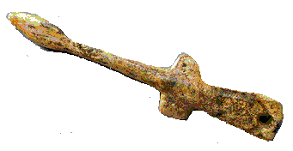
After Gravettian there were the Solutrean and Magdalenian cultures which were already discussed. Let us jump to the new migration around 12,000 BC. It is the time when Vega was the polar star. Next migration is the early Neolithic around 6000 BC. It is a period when there was no polar star. This migration probably had technological origins: early farmers pushed the hunter-gatherers further to the North. There were major catastrophes at that time, caused by the melting ice. In Norway Storegga Slides fell to the sea and triggered a tsunami around 6,100 BC and the Bosphorus strait may have opened in the Black Sea in 5,600 BC with a catastrophic flood, in 7,400 BC with a minor flood, or some other way (the case is still open). No doubt there were floods somewhere in Europe when the ice melted and this time qualifies as one end of ages. The old theory of ages and the catastrophe at the end of the times can very well be based on actual events. The end of the times is never the end of the world. After the end new heavens and new earths are created, i.e., the night sky has different stars when the new world pillar is set and different people occupy the lands.
The last two major migrations from the Pontic-Caspian Steppe: R1b people around 3000 BC and R1a people around 2600 BC had a technological component, they had horses, but the time fits into Thuban, the star of Draco.
Thuban was the polar star in the time of the Old and Middle Kingdoms of Egypt. It lost its position as a polar star in 1700 BC. This is the time of the second intermediate period in the history of Egypt. Hyksos ruled Lower Egypt. Then Hyksos were either pushed away or they left voluntarily. I think this exodus was the origin of Exodus and its cause was the new polar star, Kochab. I also think this is the origin of the myth of the Promised People. Celestial constellations were understood as gods but astrology, which already was developing around 1600 BC, has the basic belief that celestial phenomena have a correspondence with Earthly phenomena. The new polar star had an association with a certain people. The protector of Egyptians was Draco. They did not conceptualize Draco as a snake but as a hippopotamus carrying a crocodile, and as crocodiles live in Nile, this constellation was beneficial for Egypt. The new polar star Kochab in the constellation Ursa Minor must have been a protector of some other people.
The square of Ursa Minor may be understood as a celestial temple with two pillars: Kochab and Pherkad. It is agreed that Jacob’s ladder is a world pillar, but as a ladder it actually has two pillars. The Temple of Solomon had two pillars: Boaz and Joachim, cabbalistic Severity and Mercy. Jacob had twelve sons, which looks like a reference to 12 months but also to 12 zodiac signs. Israelites had a world ages theory with three 2000 year long ages and one 1000 year long. It is supposed to be derived from the Genesis story of creation of the world in six days, but that story itself is originally a world ages model and not so much different from the Hindu world ages model. Every world age ends to a catastrophe, such as the deluge of Noah, or to Manu’s flood as in Hinduism. The God of the Israelites was El, the Canaan high god, which the Greeks identified with Kronos, the time, later confused with Saturn. Kronos tries to keep the age from changing by eating his children, but finally Zeus survives and kills his father. It is a reference to the end of the age when the gods are changed. As gods were identified as celestial constellations, this myth retells the changing of the polar star, the fall of the world pillar. The fall of Thuban and the raise of Kochab meant that a new nation was chosen as the Promised People of the new god, who actually is only a form of Kronos, the high god of the time.
This, I think, is the real content of the theory of ages and the world pillar. The theory developed into the Messianic plan of a future Savior, who saves the humanity from the end of the times. We still see this though in many modern religions, not only in Judaism, Christianity and Islam, but also in Hinduism and Buddhism. It was just percussion.
References:
[1] Ugo de Santillana and Ertha Von Dechend, Hamlet’s Mill, 1983.
[2] Giulio Magli, “On the possible discovery of precessional effects in ancient astronomy”, https://arxiv.org/ftp/physics/papers/0407/0407108.pdf
[3] Qiaomei Fu et al., “The genetic history of Ice Age Europe”, Nature, 2016.